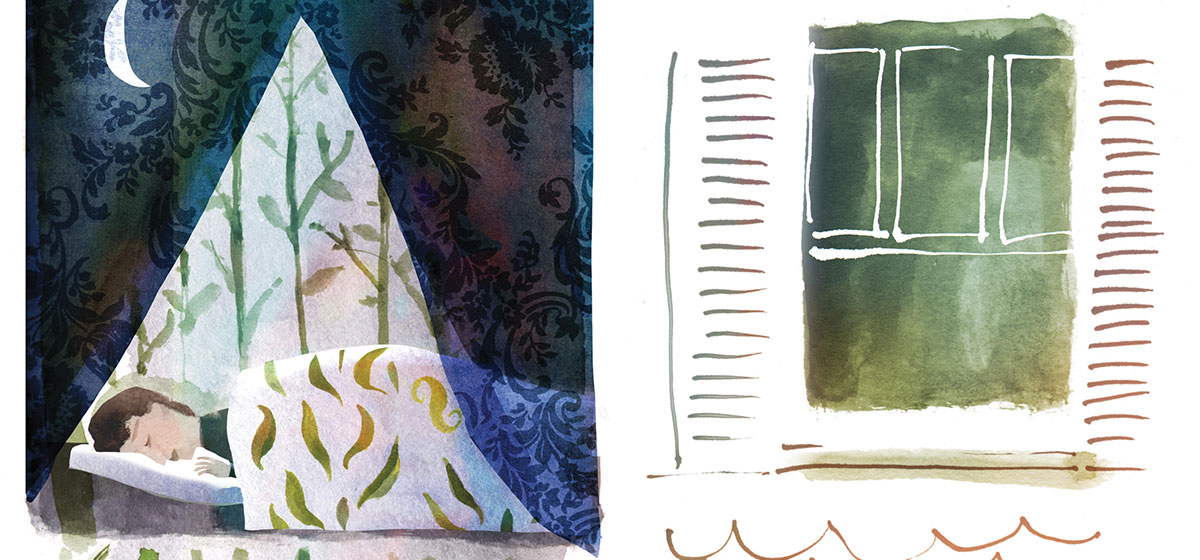Our Sleeping Porch

“There was nothing of the giant in the aspect of the man who was beginning to awaken on the sleeping porch of a Dutch Colonial house in that residential district of Zenith known as Floral Heights. His name was George F. Babbitt.” — “Babbitt” by Sinclair Lewis
The joys of a sleeping porch are many, but the greatest is a warm morning before dawn. The windows are flung open and I lie in bed listening to a chorus of birdsong. From the surrounding woods, the symphony builds to a crescendo as the sun rises, the notes loud and jumbled, perhaps the closest western Pennsylvania will ever get to the sounds of a jungle. I try to distinguish one bird from another, occasionally recognize a Carolina wren or an Eastern towhee, but for me the divine pleasure is in the whole.
“Oh, you have a sleeping porch,” people always exclaim, their eyes lighting up, when I show them around our old farmhouse. Just before we bought this farm in 1988, my husband and I had slept on a friend’s porch in Norfolk, Conn., and afterward my husband suggested we add one onto our new bedroom; I agreed. We enlisted our friend and architect Ellis Schmidlapp and soon found ourselves discussing window treatments, roof angles and drainage. Ours was the first and only sleeping porch Schmidlapp designed in 40 years of architectural practice.
Today, sleeping porches may seem quaint or out of a different time, but they were once standard treatment in domestic architecture, evolving — how odd it feels to write this — during another global health crisis: tuberculosis. TB is an infectious, airborne disease that most commonly affects the lungs and was prevalent in this country from the mid-19th century until the 1940s when streptomycin, an antibiotic, was discovered. TB patients were usually quarantined in sanitoria or at home.
“One of the most important stated goals of the home rest cure was to provide the greatest amount of fresh air possible, to bring the outdoors in,” wrote Katherine Ott in her book, “Fevered Lives: Tuberculosis in American Culture since 1870.” Some patients slept outdoors in tents, lean-tos or cabins; others transformed existing porches into makeshift bedrooms or slept near open windows. The Farlin window tent was a tortuous-looking contraption attached to a window and protruding indoors to cover a patient’s upper body. “Around the turn of the century,” Ott wrote, “the presence of a sleeping porch indicated respiratory problems in a family as clearly as if a marching band had been hired to announce it.” And by 1910, “sleeping outdoors and exposure to fresh air had become a part of general middle-class culture.”
The Aeroshade Company of Waukesha, Wis. made awnings for sleeping porches in 1916 that “do not absorb and retain heat, but keep it out,” and to meet the “popular demand” of sleeping porches, the 1917 Aladdin House Catalog of Bay City, Mich., which sold house plans, offered two pre-fabricated sleeping porch additions. “No. 5” was two stories high, 10 feet by 6 feet, the upper story big enough for a double bed, two twins, or three cots, and cost $100, including screens, and interior and exterior paint, stain or oil. The slightly larger “No. 6” was 14 feet by 7 feet and cost $149.50. “The popularity of the sleeping porch needs no comment here,” claimed the catalogue copy. “This makes a splendid addition to any house.”
Frank Lloyd Wright designed sleeping porches too, including those for western Pennsylvania’s own Fallingwater. As Donald Hoffmann wrote in “Frank Lloyd Wright’s Fallingwater: The House and Its History,” Wright’s bedroom designs for Fallingwater were small, simple and “meant to serve almost as antechambers to their respective terraces, each of which offered more floor space.” In 1921, about 14 years before commissioning Wright to design Fallingwater, the Kaufmanns had built at Bear Run — from the same Aladdin catalogue — a “Readi-cut” cabin with screened porches where, according to Hoffmann, the Kaufmanns had become accustomed to sleeping outside. Then, with the design of Fallingwater under way, Kaufmann had what he called a “bird cage idea” for sleeping on the terraces of his new house. “He discussed it with Wright as early as April 1936,” Hoffmann wrote, and Wright made a drawing for a “mobile, steel-framed sleeping chamber.” In 1937, however, the idea was abandoned because a Pittsburgh manufacturer was unable to make the device.
“These ideas were early in the design process,” said Justin Gunther, director of Fallingwater, “and whether or not the Kaufmanns ever pulled their walnut-framed beds out onto the terraces at night I don’t know. But, it’s certainly a romantic notion to think that Liliane might have slept on the master bedroom terrace under the stars!”
The stars and planets are another pleasure of a second-floor sleeping porch such as ours, surrounded as it is on three sides by tall windows and, at the gable end, a large fanlight window that allows us to look straight up to the heavens. Schmidlapp said he’d initially pictured conventional double-hung windows for our porch, but my husband wanted windows that swung open into the room and were removable so we could store them underneath our bed in summertime. The predominantly south-facing room has 11 screened windows in all, and in case they’re left open during a rainstorm, Schmidlapp placed drain holes on the floor with a rubber membrane underneath so water wouldn’t seep down into the dining room.
Ours is the simplest of interiors: white wainscoting and a gray wood floor. I’ve seen photos of elaborate sleeping porches with wicker furniture, fancy curtains, ceiling fans, shutters, rows of beds with matching bedding and potted hydrangeas, but we have only a bed, two side tables with lamps for reading, a wooden chest to store warm nightclothes, and a hooked rug. When the children were young, we added a small bed in case they wished to join us. Our dogs always do.
We sleep on our porch year-round, in all weather and all temperatures. I usually draw the line around the freezing mark, but my husband is of stronger stock. Winter takes the most preparation, making sure the windows are shut tightly and piling onto the bed layers of down comforters and sleeping bags. For extra warmth, I’ve been known to don a red wool “union suit” with back flaps, a nightcap and socks. Our son remembers when he was young dressing in many layers to sleep out there in winter. “Not for the faint of heart,” he said. On the coldest nights, the last — and my favorite — thing to do is to place hot water bottles underneath the sheets before climbing (running) into bed.
On a sleeping porch, the nighttime sounds of wild creatures come close: great horned owls, bullfrogs, fishers, spring peepers, coyotes. We hear the wind howl off the ridge, the roar of a swollen creek below, and rain on the metal roof. Thunder echoes off the walls, and lightning illuminates the entire room. Some nights we watch the full arc of the moon rise and set, and on moonless nights, identify constellations. In winter, we smell the first scent of snow and awaken to a white world; in summer, lightning bugs sparkle around us. When a chill takes hold in autumn, the sleeping porch retains the sun’s warmth and becomes a solarium of sorts — a wonderful place to meditate, read a book or nap.
But who wants to sleep on a sleeping porch when the world offers such gifts?




